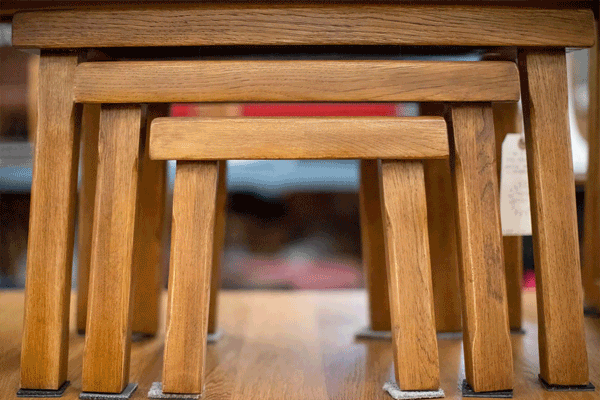In This Destruction Derby, Do-It-Yourselfers Win the Spoils
HINSDALE, Ill. — Cindy Fuqua is a home wrecker. Darn proud of it too.
She was at it again the other day in this posh Chicago suburb. Her long nails were painted red. Her blond hair swished down her back. And there she was, crowbar in hand, wrecking the perfectly gorgeous pine ceiling of a stranger’s family room.
Flush with the thrill of a deal (the ceiling cost $100), Fuqua and her husband, Sonny, ripped the pine down board by board, exclaiming all the while that they couldn’t wait to put the whole thing back up, on the porch of their Victorian home.
That do-it-yourself spirit propels the nutty world of “demolition auctions,” where folks short on cash but long on muscle can purchase whole chunks of homes scheduled for destruction--on the condition that they figure out a way to get their treasures out of the doomed house before the bulldozer arrives. From windows to banisters to toilets to kitchen cabinets, from shower heads to patios to landscaping to, yes, ceilings, everything’s up for grabs.
As demolition auctioneer Jodi Murphy puts it: “This really is adventure shopping.”
Home-wrecking is more than just a lark, however. It’s a window on a broader trend that some environmentalists consider the next big wave in recycling.
The concept is simple: Instead of crunching old buildings with heavy machinery, then dumping the debris in landfills, we should “deconstruct” them by hand and salvage all we can--from the fireplace mantle worthy of an antique store to the sturdy wood beams that could frame another house to the asphalt roof shingles that could be ground into material to patch potholes.
Deconstruction experts boast that they can take most homes and many commercial buildings down to their foundations, saving 80% or more of the material for resale or reprocessing.
The work is slow and sweaty, and traditional crunch-and-dump demolition contractors tend to call it loony as well. On big jobs, they say, they already recycle all the wood, metal and concrete they can before sending in the wreckers. Yanking nails from every 2-by-4 in a little ranch house, or saving each flimsy closet door, seems to them a colossal waste of time.
Still, deconstructionists insist that their movement, which has been gaining steam for close to a decade, is poised for a boom as more and more jurisdictions struggle to divert waste from overcrowded landfills.
“People are starting to realize that all the bottles and cans set out on the curbside aren’t going to come near to matching the amount of waste generated from construction and demolition debris,” said Julie Rhodes, director of the ReUse Development Organization, a nonprofit group that promotes innovative recycling programs.
Nationwide, demolition debris alone weighs 135 million to 165 million tons a year; the industry recycles about 40% of it. The rest is just not worth saving, argues Michael Taylor, director of the National Assn. of Demolition Contractors.
“People say: ‘Oh, you can recycle these doors, take them out, strip them down, repaint them.’ Well, you can also buy a pretty nice, well-insulated door from Home Depot for $35,” Taylor said.
William Turley, director of the Construction Materials Recycling Assn., puts it this way: “The economics of this total recovery movement are just not there.”
Then again, landfill space is fast disappearing. So some jurisdictions are starting to mandate recycling to spur the deconstruction industry.
Massachusetts, for instance, will require all recyclables to be separated before construction or demolition waste is brought to a landfill, starting in 2003. In California, the city of San Jose plans to charge contractors a sizable waste-disposal fee; they will get their money back if they can prove they have recycled at least 50% of their debris.
Salvaged Materials Used in Reconstruction
Los Angeles is about to embark on its first deconstruction project, dismantling five library branches and then using the salvaged materials--from bricks to wood framing to murals to vaults--to build updated replacements.
And Ft. Ord in Monterey has tested deconstruction of six buildings with an eye toward saving tons of reusable goodies (think 755 urinals, 2.8 million square feet of floor tile, 12,236 fluorescent lights) as the base is turned over to civilian control and most of the buildings are demolished. “What I think of as trash,” explained Stan Cook, the base’s deconstruction manager, “might be someone else’s valuable raw material.”
The concept is catching on overseas too. The European Union is poised to mandate full recycling of every building knocked down after 2010, Taylor said.
“Deconstruction is where recycling [of household goods] was in 1980: in the takeoff stage,” said Neil Seldman of the Institute for Local Self-Reliance in Washington.
Seldman touts deconstruction not only as an environmental program, but as a social one: His institute trains welfare recipients for deconstruction jobs worth $15 an hour or more. After they gain experience with tools and familiarity with the mathematics of construction, they can enter carpentry apprentice programs, which may pay even better.
The key to making deconstruction work, of course, is finding a market for used doors and worn floors and avocado-green toilets three decades old.
As it turns out, that’s not too tough.
Habitat for Humanity operates dozens of ReStores around the country that take in just such treasures for resale. (Most of their stock comes from homeowners who get rid of old stuff when they renovate.) The goods sell for up to 90% off retail price, and they move; the St. Louis ReStore, open just three years, expects to rack up close to $400,000 in sales this year.
Similar warehouses, run by both nonprofit and for-profit groups, are springing up around the country. And there’s even a market for things that can’t be reused as is: In California’s Sonoma County, for instance, a deconstruction company called Beyond Waste turns salvaged lumber scraps into chic hardwood floors. “When we started, people thought we were completely insane,” owner Pavitra Crimmel said. “But people are increasingly interested in it.”
Deconstruction’s Economics Weighed
Although deconstruction takes much longer than demolition--a six-man crew can spend a week on a single house--it is not necessarily more expensive, because the salvaged material can be sold to offset high labor costs.
Crimmel laments that she “can’t compete [economically] with a machine that just goes ‘bonk.’ ” But in Portland, Ore., a nonprofit deconstruction firm called the Rebuilding Center bids against traditional wrecking crews for demolition jobs, and often comes in with a lower price. In the black since its first month in business, the Rebuilding Center employs 30 full-time deconstructionists, stocks a 60,000-square-foot warehouse with used building supplies for sale and takes down an average of 40 homes a year.
Of course, not every property owner wants to wait for his home to be taken down nail by nail.
That’s where demolition auctions come in.
They give scavengers a day to get all the best loot out of a house. A wrecking crew then comes by to finish the job quick. The homeowner, for his part, earns money from the sale of his castoffs and saves on demolition costs, since there’s less to haul away to landfills.
Murphy’s company, Murco Recycling, runs demolition auctions nearly every weekend around Chicago. Palo Alto’s Whole House Building does the same in Northern California. It’s hard to tell how many other demolition auctioneers are in business around the nation, but deconstruction experts say it’s quite a narrow niche.
Here in Hinsdale, at least, it’s a popular concept. Scores of deal-seekers crowded the recent auction at a $550,000 frame house--built in 1918 with two fireplaces and hardwood floors--that was being torn down in favor of a $1.2-million home with stone facade and 5,000 square feet of living space.
A shower head sold for $5. A refrigerator for $350. Dave Rachus bought two pine trees for $40--and hit a gas line as he sweated to dig them up. A woman walked off with a bag of daffodils. A man unscrewed a wall-mounted TV stand.
Dave Qualy of Fond du Lac, Wis., who had driven 2 1/2 hours to the auction, bought a $700 Kohler toilet for $80 and several Pella windows for $25 apiece. “I hope this isn’t asbestos insulation,” he muttered as he forced his crowbar into the window frames, scattering a frizz of orange foam.
Out in the backyard, in the chill of a gray day, Kate and Jeff Townsend were prying brick after brick after brick from the ground. They had bought the whole patio--the whole, $4,500 patio--for just $225.
Even the home’s address numbers, painted on ceramic tile, hit the auction block. Cindy Fuqua bought them for $15. (They needed a little doctoring; the demolition home was number 221, and her own house is number 227. She figured a black magic marker would do the trick.)
“We just get so excited about this,” Fuqua said, casting about for other treasures to save from the wrecking ball. “If I could lift up this whole house and take it home with me, I would.”






